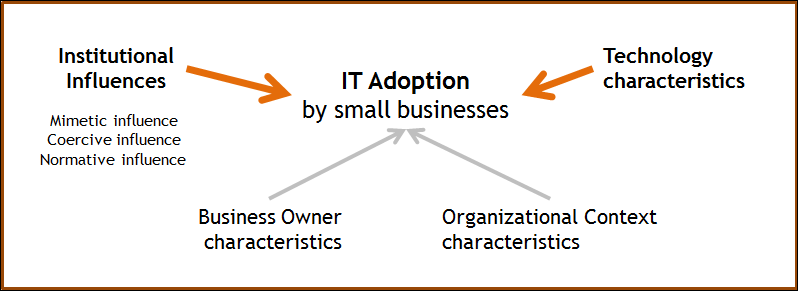Information Technology adoption in organizations can be influenced by many factors, from characteristics of the technology itself to softer criteria like external pressures or inside culture. The size of the company, the industry where it’s evolving, or the professional background of its management team can also influence IT adoption.
Back in 2006, I had the chance to complete a master degree at HEC Montréal in Information Technology management with two fantastic professors (Pierre-Majorique Léger and Suzanne Rivard) who guided me through my thesis writing, which was about IT adoption by small businesses and startups.
My goal was to identify the main reasons behind IT adoption in small businesses (ie from 50 to 150 employees). From a BA perspective, being aware of these reasons could lead to a better approach when eliciting requirements and identifying appropriate solutions.
Let’s take a quick look at the results.
Why focusing on small businesses?
Information technologies can bring a lot of value to organizations. While this is especially true in larger ones (thanks to their available financial resources, but also to the necessity to support operations on a larger scale), it can also be seen in smaller businesses.
Enterprise systems editors acknowledge this, by creating more and more applications for smaller businesses. However, like for any other dimension in an organization, large and small corporations do not behave with the same patterns.
Innovation adoption patterns for large corporations were well documented, but there was no evidence that these patterns could apply to small businesses. A thesis subject was born 🙂
Possible adoption patterns
Through my thesis adventure, I identified a few reasons that could describe adoption patterns in smaller organizations. These can be categorized in 6 domains:
- Mimetic influence | Adoption rate by competitors and their success in implementing new technology is recognized to influence the adoption of technologies by organizations. Doing it because others are doing it is always a good way to justify what we’re doing 🙂
- Coercive influence | Pressures from suppliers, customers, a head office or governments can strongly push an organization toward the adoption of a specific technology. A good example of this is how Wal-Mart can force its suppliers to adopt specific technologies to support their business relationships.
- Normative influence | Similar to mimetic influence, normative influence will push organizations to adopt a technology because other organizations are doing it. However, in this case, pressures will come from wide adoption by suppliers or customers, or from the involvement of decision makers in professional associations.
- Technology characteristics | This might be the most obvious source of influence when adopting a new technology. Its benefits, its compatibility with the organization as well as its cost will influence if an organization will adopt a technology.
- Business owner characteristics | The education and management style of the business owner (who will ultimately decide to adopt a specific technology, especially in smaller businesses) are also factors that could influence adoption.
- Organizational context characteristics | The organization size, its competitiveness, its business strategy, the availability of internal IT resources and the information-intensity level of business activities can all influence the level of adoption.
I decided to focus solely on the first 4 domains to do my research, since my main objective was to compare how well institutional influences and technology characteristics can explain technology adoption.
Based on my research model, I polled by phone 800 businesses in Quebec to learn what led them to adopt ERPs, and possibly find their adoption patterns.
Discoveries (sort of)
Since only 66 of them answered (that’s an outstanding 0.825% participation rate!), I had a hard time analyzing the results. Although my research model was proven valid, I came to the conclusion that none of these factors can explain adoption (I was lucky that my final mark on the thesis focused more on the approach than on the results!).
However, some interesting explanations were identified in the analysis process:
- The lack of adapted solutions for small businesses specific needs and the lack of financial resources for IT solutions in small businesses could explain why I wasn’t able to identify key factors;
- Adoption could be explained by factors excluded from my model, such as business owner and organisational context characteristics.
If you want to get more details on this research, you can get a free PDF copy of my thesis on the HEC Montreal library website (in French only).
Even though my research results don’t prove this, they made me think that BAs could help small businesses and startups get a better understanding of IT innovations, so that they can take decisions based on rational factors instead of relying on emotional or external factors, leading to greater benefits for the organization (wouldn’t that be a nice subject for another thesis?).
Moreover, BAs could propose non-technology based solutions (such as process improvements) that could bring results without high technology costs, which would take into account the limited resources of small businesses.
In a future post, I’ll explore how Business Analysts can contribute to smaller organizations success. Don’t want to miss this upcoming post? Just subscribe to Eric the BA newsletter by filling the form below!
Do you like what you’re reading?
Does this reflect your experience with small businesses and startups? Share your thoughts in the comments below!
Image credits: HeisenbergMedia @ flickr.com






